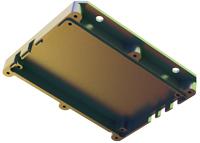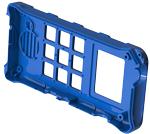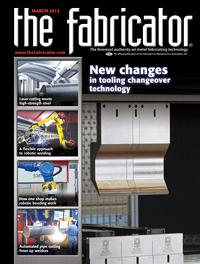Contributing Writer
- FMA
- The Fabricator
- FABTECH
- Canadian Metalworking
Categories
- Additive Manufacturing
- Aluminum Welding
- Arc Welding
- Assembly and Joining
- Automation and Robotics
- Bending and Forming
- Consumables
- Cutting and Weld Prep
- Electric Vehicles
- En Español
- Finishing
- Hydroforming
- Laser Cutting
- Laser Welding
- Machining
- Manufacturing Software
- Materials Handling
- Metals/Materials
- Oxyfuel Cutting
- Plasma Cutting
- Power Tools
- Punching and Other Holemaking
- Roll Forming
- Safety
- Sawing
- Shearing
- Shop Management
- Testing and Measuring
- Tube and Pipe Fabrication
- Tube and Pipe Production
- Waterjet Cutting
Industry Directory
Webcasts
Podcasts
FAB 40
Advertise
Subscribe
Account Login
Search
Job shop estimating: Compatibility issues
Step 3: Evaluate the fit of the product being quoted
- By Gerald Davis
- March 7, 2013
- Article
- Shop Management

Figure 1a: This component is milled from aluminum billet, sandblasted to remove machining swirls, and then plated with yellow chromate.
This edition of Precision Matters continues our detailed examination of estimating as a business process. The previous edition covered the need to retrieve the manufacturing history. Even when a history is available, the current and future circumstances of the shop will require the estimator to make certain evaluations of compatibility as part of the bidding process.
For the sake of discussion, we’ve dissected the estimator’s job into a dozen tasks. In reality, these tasks may overlap or evolve in different sequences. As a review, here is a quick outline of how we’ve dissected an estimator’s job:
- Process identification
- History retrieval
- Compatibility check
- Work order prep
- Time study
- Material planning
- Fixtures/special handling
- Costing
- Pricing
- Presentation
- Review
- Optimization
The estimator is expected to know how to dissect a product design into a manufacturing sequence. In order to limit the scope of this discussion of estimating, we’re discussing the estimator’s role in a job shop that has a trade-specific business orientation. For example, the shop might specialize in machined parts (see Figure 1a), sheet metal forms (see Figure 1b), tube (see Figure 1c), or injection-molded parts (see Figure 1d).
Figuring in Subcontractors
Many such job shops exist in a business network of specialists. Subcontracting between job shops is a routine element of a typical production run. In one instance, a machine shop might subcontract plating operations. In another instance, a casting shop might subcontract some machining work. In yet another, a sheet metal shop could subcontract the painting and screen printing.
To describe how an estimator might review the documentation provided with a request for quote (RFQ), we’ll imagine that it is done in several passes or stages. Experienced estimators, in reality, are able to perform almost all of these modes of analysis simultaneously.
An early pass through the design is made to identify which features of the product can be manufactured in-house as well as those that must be subcontracted. The next stage might be to plan a sequence of manufacturing, starting with cutting raw material, progressing through each stage of fabrication, and ending with the product ready for shipment and invoicing. With the general work sequence outlined, the estimator will need to obtain bids for the subcontracted fabrication steps. While waiting for those bids to come in, the estimator refines each of the in-house manufacturing steps in terms of material condition on input, material condition on output, labor, machinery, tooling, fixtures, software, quality control, yield, and queue time.
Clearly, a detailed cost estimate can require a significant amount of effort on the part of the estimator. To minimize wasted effort, perhaps the first-pass evaluation is to determine compatibility. If the project is not a good fit with the shop, the shop shouldn’t waste time quoting it. We’ll discuss strategy and tactics for notifying prospective customers of rejected RFQs in a future edition.
Right now we want to emphasize the subtleties involved in determining compatibility. This is essentially a measure of the degree of difficulty of the project. Part of the strategic vision for the shop is to define what the ideal project entails. That includes a list of typical fabricating requirements, as well as customer demographics and margins.
It is a matter of company policy to decide what to do about jobs that deviate from the “ideal” project. For example, the shop’s machinery capabilities allow it to hold tolerances that differentiate it from the competition. As a result, the shop’s mission might call for targeting high-precision work that demands rigorous quality control procedures to eliminate defects. This precision capability comes with some additional capital expense.
In this setting, the estimator may look at a project that has very coarse tolerances as if it required the precision capability available in-house. This decision is likely to result in a very high price quote relative to the competition’s with less capital overhead—essentially turning away the super-easy in favor of the ideal. This might be a good pricing tactic.

Figure 1b: This sheet metal part features louvers, cluster punching, and embossed countersinks with a powder coat finish.
That same estimator might come across a project that requires more than the normal degree of precision. Perhaps the parts will have to be 100 percent inspected and sorted to achieve the desired consistency in a delivered batch of parts. The tactic is to quote the hypercritical project as if it were “routine.” This will result in a low price quote relative to the competition’s, which passes on all anticipated manufacturing expenses to the customer.
This “hard-is-easy” approach will attract work aggressively at the extreme level of difficulty for the shop. This is not a sustainable business model. Giving good work away for no gain is nonsense. However, for a short period of time, it gives the business the opportunity to build a successful reputation in a particular niche. With experience based on its performance, the shop can adjust its pricing tactics over time to establish both the ideal customer margin as well as the ideal mix of manufacturing projects.
Specifically, what is an estimator looking for while trying to determine how well a project fits with the shop? We’ve already considered the impact of subcontracting as a project requirement. If too much subcontracting is needed, the project might require a delicate response to the customer.
As an example of extreme subcontracting, consider a sheet metal shop that gets an RFQ for an injection-molded part. Everything—the tooling design, tooling production, and tooling operation—would have to be subcontracted. It might be the shop’s policy to avoid this kind of work and to recommend to the customer a direct supplier of the injection molding service. However, the customer might insist—even while knowing that the majority of the project will be subcontracted. They trust the quality control procedures and scheduling management of our example sheet metal shop. This would be an opportunity to factor in a reward for good behavior and to make subcontracting of injection-molded components a routine part of our example sheet metal shop’s service.
On the other hand, it is often best to stick to your knitting. Diversity is complexity. Stay focused on your core skill set.
Verifying the Capabilities
As we mentioned in the previous edition of this article (“Job shop estimating: A historical perspective,” The FABRICATOR, February 2013, p. 38), the estimator uses retrieval tools to pull the previous history of the project when updating a price quote.In the context of a compatibility check, the estimator attempts to verify that the project can be built “same as last time.”
Given that the design of the project has not changed, the estimator needs to verify that all of the machinery, tooling, fixtures, and skill set remain available. If there is a deficiency in capacity, then the estimator might consider subcontracting or some alternative response to the RFQ.
In terms of tooling, the considerations are very trade-specific. The goal is to identify tooling expenses that must be included in the price quotation. As an example of a tooling compatibility issue, imagine working in a sheet metal shop that operates a CNC turret press for punching and profiling the flat blank. To punch a rectangular hole, punch and die tooling can be manufactured to the perfect dimension. On the other hand, a smaller punch—either square or rectangular—can be used with several strokes to carve out the desired rectangular cutout.
The estimator will need to balance the expense of obtaining the perfect tooling—in this case, the rectangular punch and die tooling—with the extra machine time, cosmetic appearance, and deburring requirements of carving the hole with several strokes using on-hand tooling. If the production batch size is large enough, dedicated tooling is a cost advantage. For small batches or quick-turn jobs, using on-hand tooling in a less-than-ideal way might be the most cost-effective solution.
In addition to tooling, basic compatibility with the machinery is a vital consideration. If the part won’t fit in the machine, the estimator shouldn’t quote the project. In the sheet metal trade, the press brake equipment presents several constraints on what is buildable. These constraints are not always intuitive to the designer. A frequent problem is sheet metal that crashes into the machine during the final folding operation. Part designers often don’t take that into consideration.

Figure 1c: This retail display piece, made from bent tubing, requires welding and polishing before chrome plating. There are no significant tolerances to worry about.
Not the least important is compatibility with the raw material. There are the obvious errors and oversights, such as calling for anodize on steel parts or tapped holes in thin sheet metal. Some materials will not flow in an injection mold given the required cross section and distance. Many metal alloys are difficult to bend in a press brake—without the proper inside bend radius the part would crack at the bend. If the estimator fails to note these pitfalls, the shop will be doomed to less-than-stellar performance by either failing to produce the promised product or by producing the project at a loss.
Each manufacturing process has limitations. These include tolerance and precision, compatibility with raw materials, weight and size range of the raw billet, and schedule availability. Trade-specific considerations include details like minimum hole size, distance from hole to bend, and depth of the hole.
Establishing a Dialogue
When the estimator is confronted with designs that violate some manufacturing constraint, the project obviously cannot be built as designed. The shop’s strategic policy will govern what the estimator is to do. It might be productive to have the estimator make design suggestions to improve the manufacturability of the project. For example, if the issue is with a hole specification that is too small, the estimator could quote it based on the hole being changed to an acceptable size and noting that deviation on the price quotation.
Sometimes the customer will welcome these helpful suggestions. This cost-savings suggestion dialogue is an additional service that adds value to the business relationship between the customer and the job shop. However, the suggestion also can be offensive to some. The customer’s response might be, How dare you question my design? It is imperative that the response to the customer’s RFQ be well thought out. If the project is rejected as a bad fit for the shop, the estimator should be prepared with a detailed statement of the reasons. Presenting those facts along with the no-bid probably will be the responsibility of the sales team.
Making an Operational Impact
One of the joys of being a job shop is being a shared resource. Over time the estimator may see a trend developing in the variety of projects that successfully pass through the shop. Perhaps that trapezoidal cutout that has been made with several machine cycles—for several different customers—should be converted to a dedicated tool or workcell. This would be an investment in tooling that the shop would make to improve its prevailing internal operating costs.
This overall review of trends in project compatibility might lead the estimator to make internal recommendations for upgrades in machinery as well as in tooling. “Designed for manufacturing” applies to the product as well as to the production line. If you find yourself subcontracting a lot of the same thing, why not do it in-house if it would improve scheduling, expense, or quality control? The review of how compatible the shop is with the target market is not always part of the estimator’s job responsibilities. However, if suggestions are solicited, the estimator has access to a gold mine of information.
Reviewing the performance history of the shop’s bids is a powerful tool. Company management can find out how compatible the estimator’s quotes are with the shop’s business goal. Again, the metrics and policies for reviewing an estimator’s performance will be specific to each firm. We will generalize by saying that a gross profit can be calculated for each project completed in the shop. A target gross profit could be established and used as one of the measures of the estimator’s compatibility with the shop.
Regular review and focused adjustments in behavior should result in harmony. Sometimes the behavioral adjustments happen on the production line, either as a result of improved work order instructions, setup procedures, or improved training.
The estimator’s performance is a function of vision. Knowing what the shop’s internal capabilities are is a vital contributor to excellent cost estimating. An occasional sabbatical as a shop worker can help the estimator to complete better time-and-motion studies and predictions for manufacturing operations. Attending tradeshows gives the estimator a chance to investigate state-of-the-art equipment, which might be needed in the future.
Visiting the customer enables the estimator to understand the context of the project. These visits can help refine packaging, inspection, and cosmetic handling procedures.
Tours of subcontractors’ facilities are another great way to expand the estimator’s skill set. Businesses change and evolve. Keeping up with the best in the shop’s business network gives the estimator a definite competitive advantage.
Is there a difference between a salesman and an estimator? Of course there is. The estimator is primarily an in-house resource. Sales guys are more out-house, as it were. At the interface between marketing and production, the estimator deals with confidential and proprietary information; is sensitive to technical limitations; is aware of the status of current production; is in a forecasting mode; and is always cautious, thoughtful, and calculating. Compatibility is the rule.
We would be delighted to hear from you to help us improve this discussion of estimating. If you have any observations on this subject matter, please let us know.
Gerald would love to have you send him your comments and questions. You are not alone, and the problems you face often are shared by others. Share the grief, and perhaps we will all share in the joy of finding answers. Please send your questions and comments to dand@thefabricator.com.
About the Author
subscribe now

The Fabricator is North America's leading magazine for the metal forming and fabricating industry. The magazine delivers the news, technical articles, and case histories that enable fabricators to do their jobs more efficiently. The Fabricator has served the industry since 1970.
start your free subscription- Stay connected from anywhere

Easily access valuable industry resources now with full access to the digital edition of The Fabricator.

Easily access valuable industry resources now with full access to the digital edition of The Welder.

Easily access valuable industry resources now with full access to the digital edition of The Tube and Pipe Journal.
- Podcasting
- Podcast:
- The Fabricator Podcast
- Published:
- 04/16/2024
- Running Time:
- 63:29
In this episode of The Fabricator Podcast, Caleb Chamberlain, co-founder and CEO of OSH Cut, discusses his company’s...
- Industry Events
16th Annual Safety Conference
- April 30 - May 1, 2024
- Elgin,
Pipe and Tube Conference
- May 21 - 22, 2024
- Omaha, NE
World-Class Roll Forming Workshop
- June 5 - 6, 2024
- Louisville, KY
Advanced Laser Application Workshop
- June 25 - 27, 2024
- Novi, MI

































